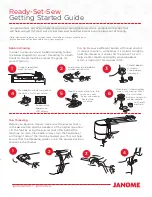Summary of Contents for select 1520
Page 1: ...Service Manual 1st Release August 2001 ...
Page 2: ......
Page 14: ...12 Notes ...
Page 17: ...15 ...
Page 19: ...17 ...
Page 23: ...21 ...
Page 25: ...23 ...
Page 31: ...29 Notes ...
Page 35: ...33 ...
Page 41: ...39 Cross check z As described under Check ...
Page 43: ...41 Notes ...
Page 45: ...43 ...
Page 47: ...45 ...
Page 53: ...51 ...
Page 59: ...57 Cross check z Carry out a visual check at straight and zigzag stitch settings ...
Page 63: ...61 ...
Page 67: ...65 ...
Page 71: ...69 ...
Page 73: ...71 ...
Page 79: ...77 ...
Page 81: ...79 ...
Page 83: ...81 ...
Page 85: ...83 ...
Page 87: ...85 ...
Page 89: ...87 ...
Page 91: ...89 ...
Page 100: ...98 ...
Page 102: ...100 Notes ...
Page 103: ...101 Notes ...
Page 104: ...102 Notes ...
Page 105: ...103 Notes ...



































